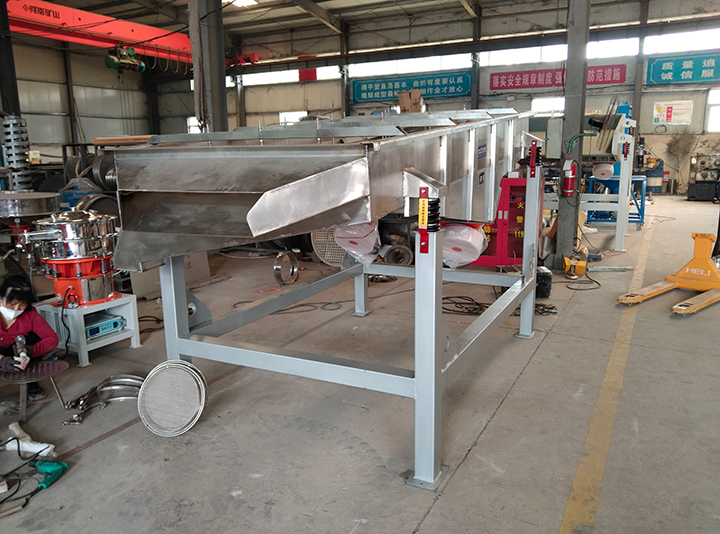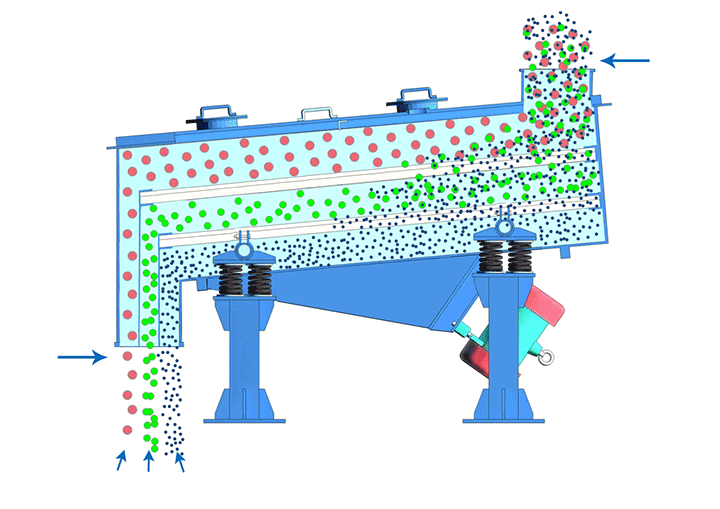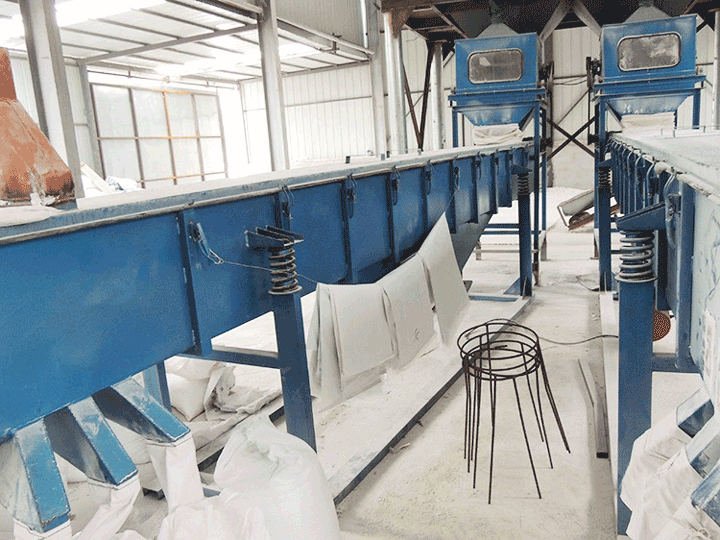The primary function of a Linear Vibrator Sieving Machine is to classify, dehydrate, remove impurities, and classify various materials using vibration. These machines are typically constructed of stainless steel, carbon steel, or plastic. They are designed to handle a wide range of materials, from fine powders to coarse particles, adapting to different material characteristics and production environments. Their processing capacities vary widely, typically ranging from a few tons to hundreds of tons per hour. For example, small machines can process several tons per hour, while large machines can reach tens or even hundreds of tons. These machines can be selected and customized based on specific production needs.

Linear Vibrator Sieving Machines use a vibrating motor to excite material, causing it to be thrown up and forward in a linear motion across the sieve surface. Depending on the material and application requirements, these sieving machines are primarily available in three types: carbon steel, stainless steel, and plastic. The following describes each type based on its characteristics and parameters. Carbon Steel Linear Vibrator Sieving Machine

Features
Rugged and Durable: The carbon steel structure is highly strong and can withstand significant shock and vibration, making it suitable for screening a variety of heavy, coarse-grained materials.
Cost-Effective: Compared to stainless steel, carbon steel is less expensive, making it an ideal choice for industries with limited budgets or low hygiene requirements.
Versatile: Widely used in the mining, coal, building materials, and chemical industries, it is particularly suitable for screening materials such as sand, stone, coal, and fertilizer.
Corrosion-Resistant: Carbon steel surfaces are susceptible to moisture and rust without special surface treatment, making them unsuitable for industries with strict hygiene and corrosion requirements, such as the food and chemical industries.
Parameters
Screen Surface Size: Customizable based on the screening load and material characteristics. Common sizes include 1000mm x 3000mm and 1500mm x 4000mm.
Number of Screening Layers: Available in single or multi-layer designs, typically 1-4 layers.
Processing Capacity: Depending on the model, the processing capacity ranges from a few tons to hundreds of tons per hour. Motor Power: Typically two vibrating motors are used, with power determined by the size and processing capacity of the screening machine. Common options include 2.2kW x 2 and 4.5kW x 2.
Features
Corrosion-Resistant and Durable: Stainless steel offers excellent corrosion resistance, effectively resisting attack by acids, alkalis, and other chemicals, extending the machine's service life.
High Hygiene: The smooth, easy-to-clean surface resists dirt and grime, meeting hygiene standards for industries like food and effectively preventing material contamination.
Aesthetic Appearance: Stainless steel offers a sleek, bright appearance, enhancing the machine's overall aesthetics.
Higher Cost: Compared to carbon steel, stainless steel is more expensive, resulting in a higher price.
Material: Typically made of 304 or 316L stainless steel, 316L being more corrosion-resistant and suitable for use in specialty chemical industries.
Features
Lightweight and Corrosion-Resistant: Plastic is lightweight and corrosion-resistant, making it particularly suitable for screening highly corrosive, lightweight materials. Spark-Free: Plastic is a non-conductive material and does not produce sparks, making it suitable for screening flammable and explosive materials with enhanced safety.
Material-Free: Plastic prevents contamination by metal ions, making it suitable for screening high-purity and high-cleanliness materials.
Lower Strength: Compared to carbon steel and stainless steel, plastic has lower structural strength and is unsuitable for screening heavy or high-impact materials.
Parameters
Screen Surface Size: Relatively small, typically 600mm x 1500mm, 800mm x 2000mm, etc.
Number of Screening Layers: Typically 1-2 layers, not suitable for multi-layer configurations.
Processing Capacity: Due to strength limitations, the processing capacity is relatively small.
Motor Power: Low power, typically 0.75kW x 2 or 1.1kW x 2, etc.

The Linear Vibrator Sieving Machine is a common screening equipment with a simple structure and easy maintenance. It is easy to operate, highly automated, and suitable for continuous production. It offers superior screening performance, high efficiency, high precision, and anti-clogging features. It is also highly adaptable, with a variety of materials and multi-layer designs available to suit different materials and industry requirements.
Compact Structure and Easy Maintenance: The vibration source uses a vibrating motor with a simple structure, easy installation and maintenance, and low noise generation.
Easy Operation and High Automation: The high degree of automation allows for continuous operation, requiring operators to perform simple parameter settings and daily monitoring.
High Screening Efficiency and High Capacity: The material moves linearly across the screen surface, advancing quickly and evenly, effectively improving screening efficiency.
High Screening Precision and Anti-clogging: The unique screen structure effectively prevents clogging, ensuring high-precision screening.
Wide Screening Range: The machine can process materials with particle sizes ranging from 0.074 mm to 20 mm, making it suitable for screening, grading, and removing impurities from a variety of fine powders and granular materials. A variety of materials are available to meet diverse needs: The screening machine can be made of stainless steel or carbon steel, depending on the material characteristics, offering high adaptability.
Multi-layer design for flexible application: It can be designed as a single-layer or multi-layer structure based on screening requirements, enabling simultaneous screening and grading of materials of various particle sizes.

The Linear Vibrator Sieving Machine is a device that uses a vibrating motor to screen materials through excitation force. Its core operating principle lies in the linear vibration motion pattern, which creates a regular tossing and forward motion of the material on the screen surface, thereby achieving efficient grading. This device typically uses two or more vibrating motors as the excitation source. These motors are symmetrically mounted on either side of the screen box at specific inclinations and orientations. When the motors rotate synchronously in opposite directions, the centrifugal forces they generate cancel each other out horizontally, while adding together in the direction perpendicular to the motor axis to create a powerful combined excitation force. Due to the inclination of the motors, this combined excitation force causes the screen box to undergo periodic reciprocating motion in a linear direction. The combination of these two motions creates a continuous parabolic motion of the material on the screen surface. As the material is thrown up, gravity forces fine particles to quickly pass through the sieve apertures and fall to the lower layer, while larger particles continue to move forward in the next throwing cycle. This continuous cycle of throwing, falling, and advancing effectively prevents material clogging at the sieve apertures, ensuring a continuous and efficient screening process. By adjusting the excitation force of the vibrating motor, the inclination of the screen box, and the material feed rate, the material's trajectory and residence time on the screen surface can be controlled, enabling precise screening of different materials.

Due to its stable sieving performance, the Linear Vibrator Sieving Machine is widely used in the grading and processing of various materials. Its application scenarios are primarily based on the need for particle size separation. The following are its main application scenarios:
Material grading: It can separate a mixture of particles of different sizes into multiple grades according to preset sieve aperture sizes. For example, coarse, medium, and fine particles can be sorted simultaneously to meet the varying requirements of subsequent production or use. Impurity Removal and Purification: During the production process, materials may contain irregular large impurities or fine dust. The Linear Vibrator Sieving Machine can effectively separate these impurities, thereby improving the purity of the final product.
Dehydration and Media Removal: For materials containing water or media (such as coal slurry and ore slurry), the Linear Vibrator Sieving Machine can use the vibration of the screen to separate solid particles while simultaneously discharging liquid, achieving solid-liquid separation.
Cooling and Heating: In certain industrial processes, the Linear Vibrator Sieving Machine can simultaneously cool or heat the material by introducing cold or hot air while screening.
Quality Control: At the end of the production line, the Linear Vibrator Sieving Machine can be used for final screening of finished products to ensure that all leaving the factory meet specific particle size standards, thereby ensuring product quality.
The Linear Vibrator Sieving Machine, due to its specific performance in material handling, plays a role in various industrial fields. Its design and operation enable it to reliably perform tasks such as classification, dehydration, and media removal. By adjusting the vibration frequency and amplitude, the device can adapt to the screening requirements of different materials. In practical application, this equipment can meet the needs of various material processing processes. Its structural characteristics and operating mode make it a routine component of industrial production processes for the initial sorting and processing of materials.
Address:China,Yanjin county forest park gate to the west 1000 meters north road.